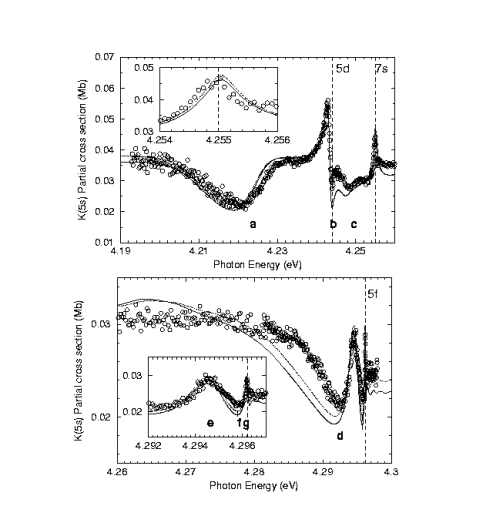PHOTODETACHMENT OF K-
Chien-Nan Liu
Department of Physics, Kansas State University, Manhattan, Kansas 66506, U.S.A.
A comprehensive eigenchannel R-matrix study of
K- photodetachment is presented over the energy
region from the K(5s) threshold to the K(7p) threshold.
Present results are compared with prior theoretical
and experimental studies. The calculated K(5s)
partial cross section between the K(6p) and K(5f)
thresholds are in good agreement with the recent relative
measurements of Kiyan et al1. However, theoretical
analyses reveal a different structure underlying the
observed resonances, compared with the one obtained by
fitting measured partial cross section to a resonance
profile formula. A complete list of energies and widths
for the predicted 1Po resonances in the energy region
studied is provided. Using the standard projection
operator method, all 1Po resonances in the energy region
studied are analyzed and their corresponding doubly
excited states are identified.
Detailed theoretical analyses provide insight into
the underlying structure and dynamics of K-.
Comparing current results and prior studies on He- and
other alkali negative ions, one observes that, as the
alkali negative ions become heavier, the approximate
symmetry of pure three-body systems breaks down. In
stead, the spectra is dominated by complicated
channel coupling. The asymptotic behavior of
electron-atom interaction plays an important, but not decisive,
role in the structure of negative ions. Recently, a
semiclassical model based on a single-channel induced
dipole potential has been used to derive formulas describing
resonance positions2 and widths3. However,
the common occurrence of channel coupling in negative
alkali ions certainly limited the applicability of these
formula. Besides, without theoretical input, it is impossible
to distinguish resonances from different series
when more than one series overlap. Therefore, a pure
induced dipole potential is not sufficient to describe
the structure and dynamics of negative ions. One has
to take into account effects due to electron correlation
in the region close to the nucleus and channel coupling.
Figures:

Figure 1: Partial cross section for the process K- + γ - K(5s) + e-
in the photon energy range from 4.19 eV to 4.26 eV.
Curves: present results in dipole velocity (solid) and dipole length (dotted) approximations.
Circles: relative experimental measurement of Kiyan et al.1 normalized to
the theoretical
predictions. The inset shows a normalized comparison between theory and experiment
near the K(7s) threshold. The vertical dashed lines indicate the locations of the thresholds.
References:
1) I. Yu. Kiyan, U. Berzinsh, J. Sandström, D.
Hanstorp, and D. J. Pegg, Phys. Rev. Lett 84, 5979
(2000).
2) I. Yu. Kiyan, U. Berzinsh, D. Hanstorp, and D. J.
Pegg, Phys. Rev. Lett 81, 2874 (1998).
3) I. Yu. Kiyan, Phys. Rev. Lett 84, 5975 (2000).
This work was supported by the
Chemical Sciences, Geosciences and Biosciences Division,
Office of Basic Energy Sciences,
Office of Science,
U.S. Department of Energy.
Submitted to ICPEAC 2001, July 2001 in Santa Fe, NM.
This abstract is also available in
Postscript or
Adobe Acrobat formats.
